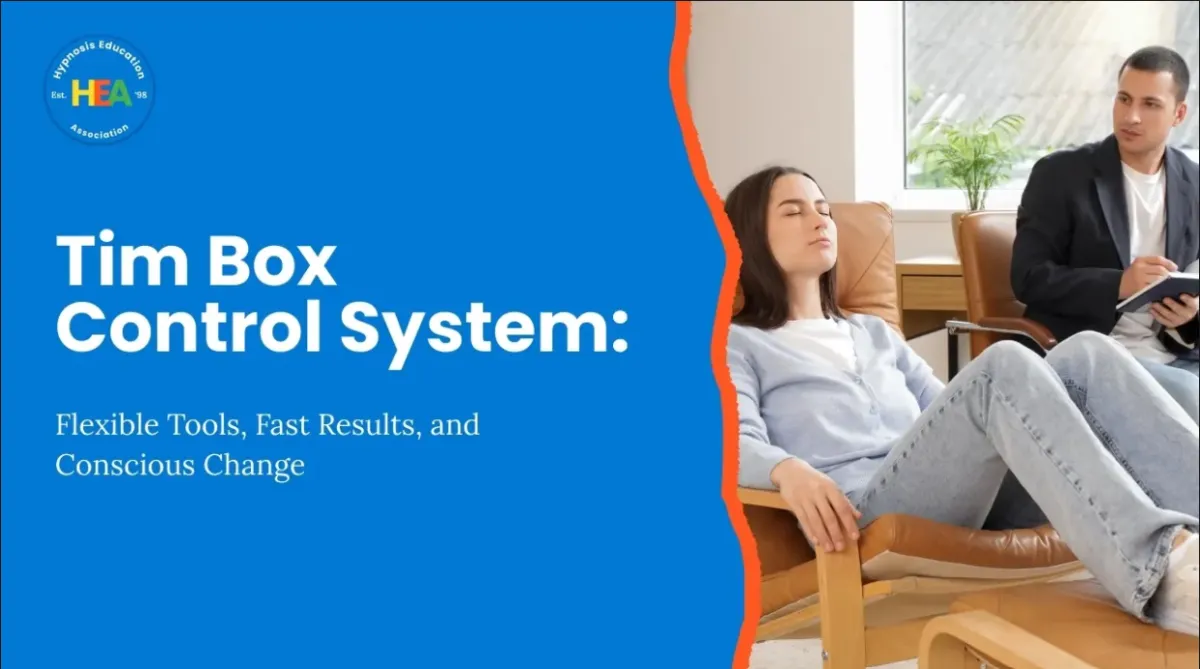
Inside the Control System: Tim Box on Hypnosis Without Trance
Tim Box Control System: Flexible Tools, Fast Results, and Conscious Change
In a field long dominated by closed eyes, trance states, and structured scripts, a quiet revolution is taking place. At the forefront of this shift is Tim Box and his Control System, a flexible, client-centered approach to subconscious change that challenges traditional assumptions of what hypnosis must look like. In a recent in-depth session, Tim shared his philosophy, methods, and results with an engaged community of hypnosis professionals, many of whom walked away rethinking the way they work with clients.
Let’s unpack the core ideas from this powerful discussion, point by point, and explore what this “new era of hypnosis” actually looks like.
Why Tim Box Stepped Away from Traditional Trance
Tim began his journey with the same tools many hypnotherapists use: eyes-closed trance work, induction scripts, and regression techniques. But over time, he found himself questioning the necessity of it all.
Instead of relying on deep trance to access the subconscious, Tim moved toward open-eyed work, using IDM (Ideomotor) responses, a form of finger signaling, as his primary communication tool. His clients stay fully alert, aware, and active in the process, which often leads to faster and more lasting change.
“I still call it hypnosis,” he said. “But not everyone agrees with me.”
A Simpler, Smarter Way to Work with the Subconscious
One of the biggest takeaways from Tim’s approach is simplicity. It’s his main mantra: Keep it simple.
Tim believes that overcomplicating the process can get in the way of results. “If we join our client in all their complexities with a complex system, we don’t get as good a result,” he explained.
That’s why he avoids heavy regression techniques and doesn’t chase after root causes. Instead, he helps clients engage with their subconscious in real time, using IDM finger signals to uncover the inner “crew members” who are trying to navigate the ship (the client) with sometimes conflicting motives.
The Role of Humor and Human Connection in Change Work
One of the most subtle yet powerful elements in Tim Box’s approach is his use of humor and humility to disarm tension. Throughout the conversation, he frequently joked about himself, calling his style “annoying” rather than “hypnotic” and teasing the idea that his clients can stare at anything they like during a session, as long as it's not directly at him: “That’d be weird.”
This light-heartedness isn’t just comic relief. It serves a critical purpose. Humor creates safety, breaks pretense, and lets the client’s guard down. That space, where people feel seen and not judged, is where real change can happen.
Tim shared how just watching a client’s fingers wiggle, triggered by subconscious agreement, often leads to a moment of shock, wonder, or even laughter. That reaction alone can start shifting a belief the client thought was immovable.
Why He Tests Clients Before Accepting Them
Tim made it clear that he doesn’t take on every client who walks through the door. During the initial consultation, he checks for responsiveness to ideomotor (IDM) responses. If a client isn’t getting clear finger signals, he might decide not to proceed.
This isn’t a judgment, it’s a matter of practicality. Tim wants to ensure that his favorite tool, which he uses to build the Control System, will work with this person. “Nine out of ten people are fine,” he said, “but I don’t want to find out in session one that the method I love doesn’t work with you.”
By front-loading this discovery during the free consultation, he ensures that the actual paid sessions deliver transformation, not confusion or frustration. And that, again, reinforces his ethics-first mindset: don’t charge people until you’re confident you can help them.
When Hope Is the Breakthrough
The word hope came up repeatedly in this talk, and not by accident. For many clients, Tim said, the most powerful shift happens before the formal hypnosis even begins.
Some clients come in and say, “You’re my last hope.” Others report that nothing else has worked. But once they see their fingers moving, proof that their subconscious is engaged, they light up. “That’s different than anything I’ve ever done,” they say.
And that alone, that glimmer of difference, restores their belief that change is possible.
One attendee called it “the bottle of hope.” Just a drop of it, she said, is sometimes all a person needs to take the first real step forward.
Meet the Crew: A Fresh Take on Parts Work
While Tim doesn’t formally align himself with “Parts Therapy,” his work bears some similarities. He describes different aspects of the client’s subconscious as crew members on a ship. Each crew member has a job, a voice, and a perspective, and sometimes, they’re just not on the same page.
The beauty of Tim’s method is that it allows these crew members to communicate directly through finger movements. With each session, clients can identify which part of themselves is responsible for a behavior, whether it’s a fear, a belief, or a stuck pattern, and begin to negotiate shifts right then and there.
Hope Starts in the Consultation
Before beginning any formal sessions, Tim always offers a free initial consultation. And he’s very clear about why:
He doesn’t want to take on a client if he’s not sure he can help.
He wants to see if the client is responsive to the finger movement technique.
And, most importantly, he wants the client to walk away with hope.
As Tim said, “A lot of the time, you give someone hope back, and the lion’s share of the work is done.”
Even during that first consultation, many clients begin to see shifts. Tim demonstrates the finger signaling technique (IDM/MOT), and often, just watching their fingers move in response to subconscious questions gives clients a new sense of agency and belief that something can finally change.
A Three-Session Structure That Makes Sense
Instead of selling sessions one at a time, Tim offers clients a three-session program. This helps set expectations and gives clients a clear process with a defined beginning and end.
He explained: “People like to buy programs rather than session-by-session. It tells them: I take you seriously, and we’ve got a structure.”
That structure includes:
An initial consultation with a finger signaling demonstration
A clear explanation of how subconscious communication works
Targeted, client-led work using their responses, not imposed scripts
This model builds confidence on both sides: the client feels supported, and Tim knows he’s working with someone ready to go deep, even with their eyes wide open.
You Don’t Need Eyes Closed to Get Real Results
One of the most revolutionary ideas Tim shared is that clients don’t need to close their eyes for hypnosis to be effective.
Most of his clients keep their eyes open the whole time.
Some practitioners in the group expressed surprise at this, especially those trained with a heavy emphasis on eye closure and focus points. But Tim gently challenged that assumption, asking: “What if we’ve made certain things necessary just because we were taught they were?”
His relaxed approach to focus is both freeing and empowering for clients. They don’t need to stare at a fixed spot or enter a deep trance. They just need to be engaged and willing to allow their subconscious to communicate through movement.
As one practitioner joked, “My clients stare at a pinecone during sessions!” To which Tim replied, “Let them look wherever they want. Don’t make them worry about focus. That’s just another distraction.”
It’s Not Coaching, It’s Subconscious Work Without Trance
At one point, someone asked the obvious question: Isn’t this just coaching?
It’s not.
Even though clients stay awake and aware, Tim’s method still works directly with the subconscious mind. The difference is that he doesn’t need a formal induction or trance to do it. Instead, he leverages ideomotor responses and conversation to reveal, and shift, what’s going on under the surface.
That’s what makes the changes so fast. There’s no need to wait until the client “goes deep.” As soon as the subconscious is engaged, shifts can begin.
Why Flexibility Is the Future of Hypnosis
One of the major themes throughout the session was the importance of flexibility, both in method and mindset.
Tim emphasized that his system can be integrated into any therapist’s existing toolbox. Whether you're a traditional hypnotherapist, an NLP practitioner, or a coach, you can “dip your toe” into this method and blend it into your current work.
As he put it, “A good method has to be flexible. Because the person sitting in front of you is always the X factor.”
Another attendee echoed this sentiment by saying, “Clients don’t care what toolbox you’re using. They just want results.”
Challenging What We've Always Assumed
Toward the end of the conversation, Tim posed a powerful question to everyone listening:
What have I assumed that I didn’t realize I assumed?
He urged fellow practitioners to question the techniques and rules they’d inherited, especially the ones that have become automatic. What if some of those “truths” aren’t necessary? What if they’re just habits?
His entire Control System was born out of this kind of questioning, and the results speak for themselves.
Final Thoughts: Hope, Humor, and Human Connection
What makes Tim’s method so effective isn’t just the technique; it’s the mindset behind it.
He treats every client as a unique individual. He gives them hope, respects their autonomy, and invites their subconscious to participate, rather than be manipulated. And he does it all with a sense of humor, humility, and genuine care.
From his “bottle of hope” metaphor to his playful take on finger signaling, Tim shows that deep change doesn’t have to be heavy-handed or complicated.
It just has to work.
And in this new era of hypnosis, what works best might not look like hypnosis at all.
Want to Learn More About Innovative Hypnosis Approaches Like Tim Box’s?
Whether you’re a seasoned professional or just stepping into the world of subconscious change, there’s no better time to connect with others who are reimagining what hypnosis can be.
Join Tim Box and other leading voices at the upcoming HypnoConnect Virtual Conference, hosted by the Hypnosis Education Association!
Explore cutting-edge techniques
Network with passionate practitioners
Get inspired to shift your approach
Register now for HypnoConnect and be part of the conversation shaping the future of hypnosis.
Let’s challenge the old assumptions, together.
